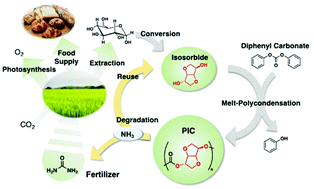Plastics to fertilizers: chemical recycling of a bio-based polycarbonate as a fertilizer source†
Abstract
Commodity polymer materials are now required to be environmentally friendly due to problems associated with resource depletion and low recycling rates, which has promoted the development of circular material systems. Herein, a novel concept is introduced, where a polymer is used as a source of a fertilizer. To demonstrate the viability of this concept, the chemical recycling of poly(isosorbide carbonate) (PIC) is presented as a model for the next generation of plastic-recycling systems. PIC, a bio-based polymer known for its excellent physical properties, undergoes a degradation reaction with aqueous ammonia. Monitoring the degradation behavior by 1H NMR and FT-IR spectroscopy as well as gel-permeation chromatography revealed that PIC completely decomposes within 6 h at 90 °C to afford isosorbide and urea. The utility of isosorbide and urea obtained from the degradation of PIC as fertilizers was demonstrated via plant-growth experiments. The generation of fertilizers via polymer degradation in the present study is expected to lead not only to innovative chemical recycling systems to address the environmental problems associated with polymer materials, but also to provide solutions to the food-production problems associated with the growth of the global population.



 Please wait while we load your content...
Please wait while we load your content...